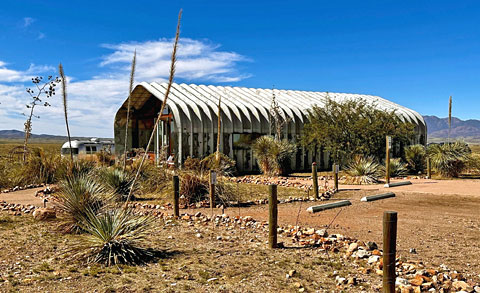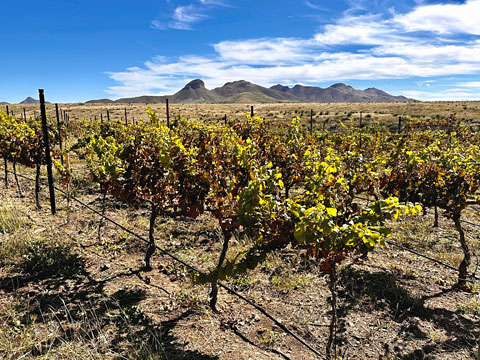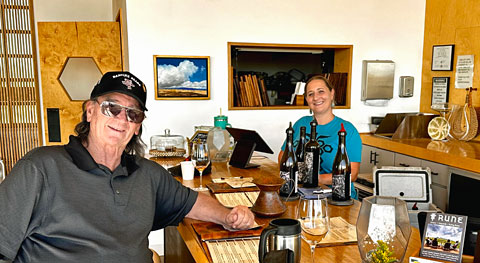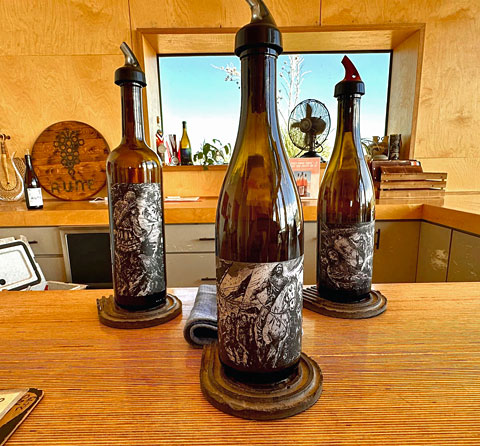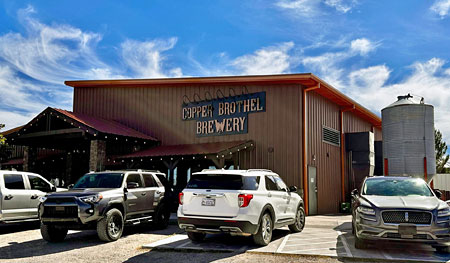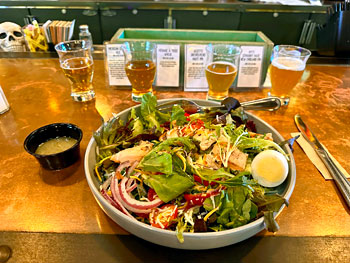Visit to Rune Wines in Arizona – October 23rd, 2025
I went on a late-October road trip to southeastern Arizona, mainly to research family history there, but I also allowed time for sightseeing on the way there and back. And since longtime wine friend Bob Summers lives not far from where I visited, we arranged to get together a couple of times while I was in the area. Although I knew I would be traveling close by or through a couple of Arizona’s best-known wine regions – Willcox and Sonoita – a winery visit wasn’t really on my agenda until Bob suggested meeting at a winery he’d heard good things about. It looked like I would have time to do that on a Thursday morning, so we agreed to meet up at the Rune Wines tasting room in the Sonoita AVA.
Bob and I were traveling from opposite directions but we managed to both arrive at the Rune tasting room within a few minutes of one another, just before their 11am opening time. Rune is one of nearly 20 wineries near the towns of small towns of Sonoita and Elgin in southeastern Arizona, only about an hour’s drive from Tucson. The distinctive arched quonset hut-style tasting room building was easy to spot from the adjacent road. There’s a modestly-sized estate vineyard near the Rune tasting room as well. The doors were open when Bob and I walked up, and we were welcomed in by Michelle, who was just finishing getting everything ready to go for the day’s visitors. The tasting room’s airy interior features welcoming light-colored wood panels, and there’s a handsome L-shaped wood tasting bar on one side of the space.
We learned that the tasting room building was built by Rune owner / winemaker James Callahan. It was designed from the start to be off-grid – it’s the only solar-powered off-grid tasting room and vineyard in Arizona. As with so many other vintners, James didn’t start out with a wine career in mind, and his degree from Arizona State University was in history. He’d thought about getting a master’s degree in architecture but a job at a Tempe restaurant opened his eyes to fine wine and he’s never looked back. James worked at wineries in Arizona, Napa Valley, Walla Walla, and New Zealand, before working his way up to cellarmaster at Kosta Browne Winery in Sonoma County. After that, he returned to Arizona where he was the winemaker for two wineries. James founded his Rune label in 2013, and produced the first Rune wines in that vintage. He purchased the property for his winery that same year, and the tasting room was completed in 2016. Though the Rune wines are currently produced at nearby winery, James hopes to build a wine facility on his property in the future.
The Rune name ties in with James’ background studying history, and the winery website notes that ancient rune letters are said to be powerful symbols of divine origin. James produces a number of different wines for Rune, with a focus mainly on Rhône grape varieties. Fruit is sourced from a number of Arizona wine regions, and all of the wines that Bob and I tasted during our visit came from vineyards in the Willcox region farther east from Sonoita. Arizona winegrape-growing regions are at higher elevations to avoid the heat of lower areas such as Phoenix. Rune is located at just under 5,000-foot elevation, and Michelle told us that they grow Viognier, Grenache, and Syrah at their three-acre vineyard by the tasting room.
All of the Rune wines are fermented with wild or native yeast, and are made with low-intervention methods. The “Wild Syrah” was the first Rune wine that James made with wild yeast, and he considers it to be their flagship wine. The distinctive labels for the wines, designed by artist Daniel Helzer, are different for each bottling and each vintage. Each wine tells a story, and James likens this to a sort of graphic novel (with descriptive text on the back label) that progresses vintage by vintage. In addition to Rune, James has a second label called Brigand Wines, and he’s also the consulting winemaker for two other Sonoita-area wineries.
Bob and I chose a couple of seats at the tasting bar, and we went through the entire lineup of Rune wines that were available for tasting that day. The tasting menu changes from time to time, and there’s typically a rosé plus a selection of four or five white and red wines. In addition to the wine tasting menu, Rune offers a food menu with mostly small bites and charcuterie, and although Bob and I didn’t have any food there, we saw a couple of other tasting room visitors enjoying some and it looked delicious.
We began our tasting with the 2023 Rosé. Fermented in stainless steel, it’s a saignée made from the juice of all of Rune’s red varieties for the vintage – Grenache, Syrah, Mourvèdre, Graciano, Malbec, Cabernet Sauvignon, and Petite Sirah. Though the red-fruited aroma and initial flavors were quite pleasant and the acidity was good, I thought the finish tailed off a bit – this might would have been better paired with food.
Michelle continued with a couple of white wines, starting with the 2023 Malvasia Bianca, sourced from two vineyards and made in both Italian clay amphora and stainless steel. Malvasia’s floral character can often be too much for me, but this rendition was particularly good – I suspect that the amphora helped tone down the intensity of the aromatics in a positive way. It still had upfront floral notes along with citrus fruit, and a lively mouthfeel and finish. Next was the 2023 Roussanne – the fruit for this came from Rhumb Line Vineyard, and the wine was fermented and aged in neutral oak. This had a pear and stone fruit profile with savory undertones, medium-rich texture, and pleasant acidity, a good candidate for further aging.
Moving on to red wines, we tasted the 2022 Grenache, from several vineyards along the Willcox Bench. Featuring intense strawberry aromas along with an herbal note, this was medium-light bodied with a pleasant texture. The 2022 “Wild Syrah” followed – the fruit was co-fermented with small amounts of Viognier, Malvasia Bianca, and Roussanne, and was aged in mostly older barrels plus a bit of new oak. This displayed a bit higher-toned red and black fruit with some spice and savory herbal notes, fine structure with moderate tannins.
I’d noticed that the Rosé we tasted included some Graciano – a variety that’s interested me for a number of years – and I mentioned that to Michelle. She generously offered to open a bottle of their 2022 Graciano for Bob and me, even though it was not on their regular tasting list. Like the Grenache, Rune gets their Graciano fruit from multiple vineyards along the Willcox Bench, and the finished wine is a barrel selection. The wine was less fruit-forward, showing savory and spicy character along with black cherry and plum fruit, lively acidity, and good structure for continued aging.
We tasted one more red wine, the 2022 Malbec, which was sourced from Rancho San Judas Vineyard. This is Rune’s first release of Malbec, and the wine was aged in some new oak puncheons. Smoky darker berry fruit plus dried herbs and earth, with medium-full body and fine tannins, another wine that should develop well with further time in the cellar.
Michelle asked Bob and me if we’d like to try something sweet to finish up our tasting, and she poured us something quite distinctive – a NV Star Thistle Mead with Serrano Peppers. This is the first mead that Rune has produced, and it’s made with star thistle honey from Sleeping Bear Farms in Michigan and Serrano Peppers from Willcox, and barrel-aged for 28 months. Medium sweet with fresh herbal aromas, the peppers gave it a spicy kick that was in nice balance with the sweetness, and the Serrano Pepper spice lingered on the palate.
In addition to the wines that Bob and I tasted during our visit, other wines that Rune currently produces include Picpoul Blanc, Viognier, Marsanne, Mourvèdre, “Classic Syrah” (75% whole-cluster), Cabernet Sauvignon, and Petite Sirah. There’s also their “Brigand” line – a Roussanne / Viognier white blend and a Tempranillo / Graciano / Tannat red. And for visitors looking for a place to stay in the Sonoita area, Rune also has their own “Winemaker’s Casita” AirBnB accommodations located not far away from the tasting room.
The visit to Rune Wines was an eye-opening visit to a small winery in a less-celebrated wine region – often just the type of place I most enjoy checking out. Michelle was a very personable and knowledgeable host at the tasting room, and I have to thank her again for graciously opening that bottle of Graciano for Bob and me. The wines we tasted were very good across the board, and my favorites included the Malvasia Bianca, Graciano, and Malbec. And while I thought the Roussanne and “Wild Syrah” were a just notch below those three at this point, I suspect that will really benefit from a few more years of cellaring. While I’ve had a number of good Arizona wines over the years, the ones that we tasted at Rune might have been the most solid lineup of wines that I’ve tried from the state – I thought they compared well with those I’ve had from a number of better-known wine regions. If you’re looking to visit wineries in the Sonoita region of Arizona, Rune should absolutely be on your list.
At Bob’s suggestion, we had lunch after our wine tasting at the Copper Brothel Brewpub in the small town of Sonoita a few miles from the Rune tasting room. I had a large and delicious grilled chicken salad, with bacon, hard-boiled egg, tomato, red onion, cucumber, shredded cheese and lemon Dijon vinaigrette. I also got a tasting flight of four beers – Mexican ale, wheat beer, hazy IPA, and New England-style IPA, all good with the last one being my favorite. Bob had fish & chips along with a red Kölsch, and he loved both. I’d definitely recommend Copper Brothel if you’re looking for a place to eat (and maybe have a beer too) in the Sonoita area. After our lunch I headed east to visit the old mining town of Tombstone, where my great-grandfather and his two brothers ran a store during the town’s early 1880s heyday. Although Rune was the only winery I checked out on my road trip, I was very glad that I took the time to stop and taste there – it was a very enjoyable visit!
|



